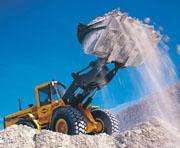 Nothing moves as much earth as humans do.© Punchstock
Nothing moves as much earth as humans do.© PunchstockHuman activities shift ten times as much material on the Earth's surface as all natural geological processes put together.
That's the conclusion of geologist Bruce Wilkinson at the University of Michigan, who has used the geological record to estimate the earth-moving capacity of natural processes over the past half a billion years. He publishes his findings in Geology1.
Wilkinson was inspired to calculate a natural 'baseline' for the movement of soil and sediment after reading a paper published five years ago by geomorphologist Roger Hooke of the University of Maine in Orono2.
Hooke called humans "geomorphic agents", comparing them to land-shaping forces of nature, such as rivers, glaciers, rain and wind.
He reconstructed the history of human impact on the landscape from intentional ground-moving processes such as excavation and mining, as well as unintentional effects caused by erosion of cultivated land.
“We're headed for disaster.”
Roger Hooke
Geomorphologist, University of Maine, Orono
Hooke found that this impact has been increasing exponentially over the course of human civilization, and suggested that "we have now become arguably the premier geomorphic agent sculpting the landscape".
Wilkinson's calculations now show that there's no argument about it: we are ten times more active at land-shifting than nature. "It doesn't surprise me," Hooke says of the finding -he already suspected that the human impact on the landscape is alarming. "We're headed for disaster," he says.
Losing the plot
The new results should help to settle an ongoing debate about the effects of human activity on soil. When natural vegetation is cleared and land is tilled for growing crops, the soil typically becomes more prone to erosion by wind and rain.
But some researchers have argued that, in the United States at least, fresh soil is being formed as quickly as existing soil is being eroded, or that, even if soil is being lost overall, it's not happening quickly enough to cause a crisis.
In the light of his comparison with natural erosion rates, Wilkinson now says that statement "is difficult to substantiate". Hooke agrees: "We're losing agricultural land rapidly." He points out that, according to one estimate, it takes 500 years for natural soil-forming processes to replace an inch of soil.
Rocky horror
Wilkinson based his estimate of natural soil and sediment movement on the rate at which sedimentary rocks have been formed over the past half a billion years. Taking into account that such rocks are also steadily destroyed as one tectonic plate slides under another, he calculates that, on average, the continents lose a few tens of metres thickness of sediment every million years.
In comparison, human earthworks and agriculture lead to a current average loss rate of about 360 metres per million years. That's enough material to fill the Grand Canyon in about 50 years, Wilkinson says.
ADVERTISEMENT
And although the figure is rising exponentially, it's not just in recent times that human activities have rivalled the effects of nature. Wilkinson calculates that human-related erosion became equal to natural processes about 1,000 years ago.
Hooke points out that a large part of the problem is simply population growth. Although modern agricultural techniques have led to a decline in the amount of earth moved per person, the world's population is growing so rapidly that this outweighs the effects of such improvements.
Geomorphologist, University of Maine, Orono
